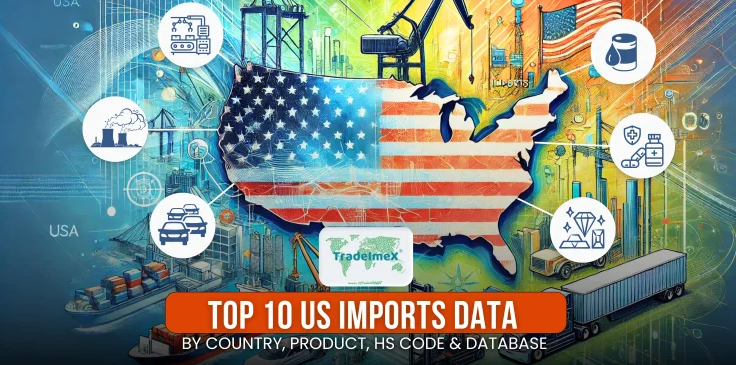Understanding US Imports & Key Trends and Insights with US import data by company
As the largest importer globally, the United States significantly influences the international economy. To grasp the critical trends shaping US imports, it’s essential to analyze the data by country, product, Harmonized System (HS) codes, and importer companies.
US import data of 2023
In 2023, US imports totaled $3.2 trillion, marking a 6% decline from 2022. By the first three quarters of 2024, imports reached $2.48 trillion, continuing a trade deficit trend of $773.4 billion in 2023-24. This article delves into the top US imports, their sources, and the companies leading the import landscape.
Top 10 US Imports by Product (HS Codes)

these are the top 10 imports of US in 2023 as per US import data
- Electrical Machinery & Equipment (HS Code 85): $463.36 Billion (14.61%)
- Includes computers, telecommunication devices, and electrical transformers.
- Powers critical sectors of the US economy.
- Nuclear Reactors & Machinery (HS Code 84): $459.19 Billion (14.47%)
- Crucial for energy generation and industrial operations.
- Vehicles (HS Code 87): $381.03 Billion (12.01%)
- High consumer demand for cars, trucks, and related motor vehicles.
- Mineral Fuels & Oils (HS Code 27): $266.59 Billion (8.4%)
- Essential for energy production and industrial use.
- Pharmaceutical Products (HS Code 30): $177.84 Billion (5.61%)
- Supports public health infrastructure.
- Special Combined Nomenclature Commodities (HS Code 99): $124.97 Billion (3.94%)
- Diverse product category meeting various market needs.
- Optical, Medical, & Surgical Instruments (HS Code 90): $118.32 Billion (3.73%)
- Critical for the US healthcare industry.
- Precious Stones, Metals, & Pearls (HS Code 71): $89.54 Billion (2.82%)
- Fuels demand in jewelry and luxury markets.
- Plastics & Articles (HS Code 39): $72.34 Billion (2.28%)
- Key raw material across industries.
- Furniture & Bedding (HS Code 94): $69.00 Billion (2.18%)
- Essential for residential and commercial spaces.
Top 10 US Import Partners
The US sources goods from diverse global markets. Here’s a breakdown of its top import partners in 2023:
- Mexico: $480.08 Billion (15.1%)
- Leading exports: Vehicles ($130.03 billion).
- China: $448.03 Billion (14.1%)
- Primary imports: Electrical machinery ($126.67 billion).
- Canada: $431.19 Billion (13.6%)
- Top imports: Mineral fuels ($131.90 billion).
- Germany: $163.08 Billion (5.1%)
- Major export: Nuclear machinery ($34.59 billion).
- Japan: $151.58 Billion (4.8%)
- Dominant category: Vehicles ($50.80 billion).
- South Korea: $119.72 Billion (3.8%)
- Key product: Vehicles ($38.42 billion).
- Vietnam: $118.94 Billion (3.7%)
- Major imports: Electrical machinery ($41.78 billion).
- Taiwan: $89.91 Billion (2.8%)
- Focus: Nuclear machinery ($34.51 billion).
- India: $87.28 Billion (2.8%)
- Top import: Precious stones ($12.36 billion).
- Ireland: $82.71 Billion (2.6%)
- Leading exports: Pharmaceuticals ($36.02 billion).
Top 10 US Importer Companies
The following companies dominate US imports, leveraging global supply chains to meet consumer demands:
Source : US importers Data
- Walmart Inc.: $50 Billion (720,000 TEUs)
- Target Corporation: $30 Billion (450,000 TEUs)
- The Home Depot: $25 Billion (400,000 TEUs)
- Lowe’s Companies, Inc.: $20 Billion (350,000 TEUs)
- Amazon.com, Inc.: $18 Billion (300,000 TEUs)
- Samsung Electronics America: $15 Billion (250,000 TEUs)
- IKEA North America Services, LLC: $12 Billion (200,000 TEUs)
- Ashley Furniture Industries, Inc.: $10 Billion (180,000 TEUs)
- Costco Wholesale Corporation: $9 Billion (150,000 TEUs)
- Dollar Tree, Inc.: $8 Billion (140,000 TEUs)
US Import Trends Over the Last Decade
| Year | Total Import Value ($ Trillion) |
|---|---|
| 2013 | 2.32 |
| 2018 | 2.60 |
| 2022 | 3.37 |
| 2023 | 3.17 |
Understanding US Import-Export Trade Under Trump’s Leadership (2017–2021)
Donald Trump’s presidency brought a major shift in U.S. trade policies, impacting domestic industries and global trade dynamics. This article examines key trade metrics, policy impacts, and proposed strategies under his leadership, particularly focusing on his “America First” agenda.
Key Takeaways from Trump’s Trade Policies
- Bilateral Trade Focus: Trump prioritized bilateral agreements over multilateral trade pacts, renegotiating NAFTA into the USMCA, ensuring tailored solutions to trade imbalances.
- Tariff-Driven Strategy: High tariffs on Chinese goods and select imports from the EU were cornerstones of his trade approach, aimed at protecting U.S. manufacturing.
- ‘America First’ Vision: Centered on protecting American workers, industries, and intellectual property, Trump’s policies emphasized re-shoring manufacturing and job creation.
Economic Outcomes During 2017–2021
The first term revealed both successes and challenges. While exports increased marginally, imports surged, expanding the trade deficit to $1.18 trillion by 2021. The renegotiation of NAFTA as USMCA offered significant wins for U.S. industries like dairy and automotive manufacturing. However, trade conflicts with China strained global supply chains and increased costs for U.S. consumers.
Market Reactions
- Stock Market Volatility: Investor uncertainty surged due to fluctuating tariffs, causing wide market swings.
- Manufacturing and Supply Chains: While some domestic industries saw short-term benefits, many faced higher costs due to retaliatory tariffs.
Proposed Strategies for a Second Trump Term
Tariff Reforms and International Relations
If reelected, Trump’s focus would likely remain on reshaping trade agreements:
- US-China Trade Rebalancing: Expanding tariffs to achieve fairer terms for U.S. exporters.
- EU Trade Partnerships: Building mutually beneficial agreements to reduce barriers and boost exports.
- Engaging Asian Markets: Establishing new trade alliances to counterbalance China’s growing influence.
Boosting American Manufacturing and Jobs
Central to Trump’s vision is revitalizing U.S. manufacturing. Strategies include:
- Investments in Key Sectors: Steel, aluminum, and advanced technologies.
- Workforce Development: Training programs tailored to evolving industry needs.
- Tariffs to Curb Outsourcing: Discouraging offshoring while incentivizing domestic production.
Looking Ahead: Implications for U.S. Trade
Trump’s potential second term would likely extend his legacy of disrupting traditional trade relationships while fortifying U.S. economic independence. Key sectors like technology, pharmaceuticals, and renewable energy could see targeted interventions aimed at reducing dependency on imports. Policymakers and businesses must prepare for intensified negotiations, new tariff structures, and evolving trade relations under a renewed Trump administration.
This reflection on Trump-era policies and their implications provides insights for navigating the shifting landscape of U.S. and global trade.
Conclusion
Understanding the top US imports and importer companies provides businesses, researchers, and policymakers with actionable insights into trade dynamics. With precise data analysis, stakeholders can optimize supply chains, reduce risks, and seize market opportunities in the ever-evolving global trade landscape.
Also read about : Trademark Registration Agency: Protecting Your Brand with Professional Expertise
